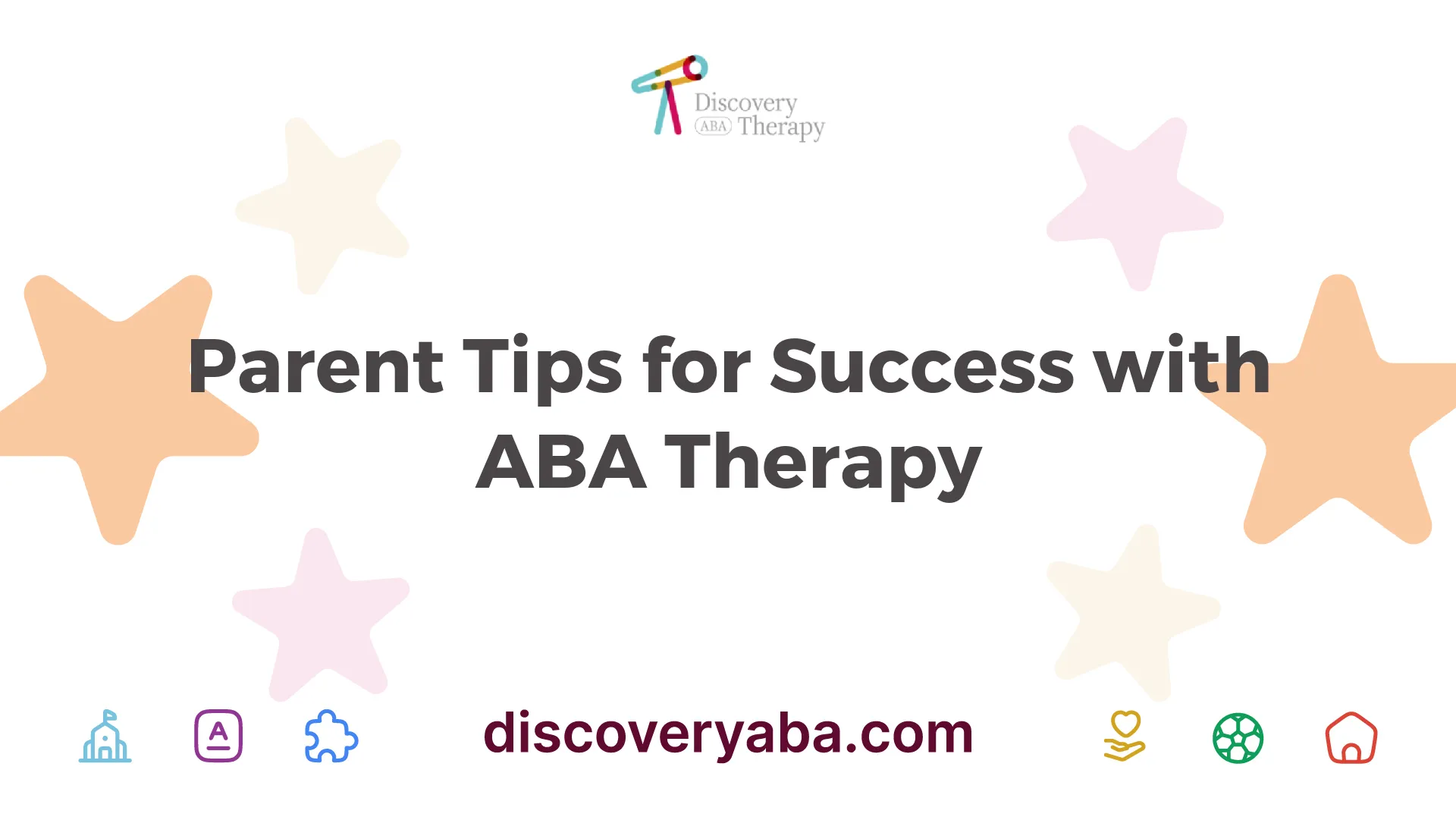Parent Tips for Success with ABA Therapy
Discover essential parent tips for ABA therapy success and support your child's journey toward growth!

ABA Therapy Overview
Understanding ABA Principles
Applied Behavior Analysis (ABA) therapy is a systematic and evidence-based approach that aims to enhance socially significant behaviors. It incorporates principles of learning theory to understand how behaviors are influenced by the environment. Techniques such as reinforcement, prompting, and shaping are used to teach new skills while reducing challenging behaviors.

ABA focuses on observable behaviors and emphasizes measurable results. Through this approach, children learn how to engage in positive behaviors, enhancing their ability to succeed in various aspects of life.
ABA TechniqueDescriptionReinforcementProviding positive feedback to encourage desirable behavior.PromptingOffering cues or hints to guide a child toward the desired behavior.ShapingGradually teaching a new skill by reinforcing successive approximations of the target behavior.
Importance of ABA Therapy
ABA therapy is recognized as a best practice treatment for individuals with autism. Supported by scientific studies, ABA has demonstrated improvements in several areas including intellectual functioning, language development, and social skills.
This therapy is often considered the gold standard when addressing autism spectrum disorders. Parents can extend the learnings from ABA therapy into their homes, creating an enriched environment that promotes ongoing learning and development. The benefits of ABA encompass:
For more insights on how to effectively implement ABA strategies at home, parents can explore our resources on how to choose an ABA therapist and how to create an autism-friendly home.

Success Factors in ABA Therapy
Successful implementation of Applied Behavior Analysis (ABA) therapy relies on several key factors that parents should consider. Focusing on early intervention, creating personalized programs, and applying positive reinforcement strategies can significantly enhance the effectiveness of ABA therapy for children diagnosed with autism.
Early Initiation of Therapy
Starting ABA therapy at an early age can lead to better outcomes. Research shows that children typically benefit from beginning therapy between ages 2 and 6. Early initiation can aid in developing essential communication skills, following directions, and preparing for preschool [3].
Age of InitiationBenefitsAge 2Improved communication skills, readiness for preschoolAge 3-4Enhanced social skills, problem behavior managementAge 5-6Support for educational needs, daily living skills
Personalized ABA Programs
Personalization of ABA programs is essential to address the unique needs of each child. Tailoring programs allows for strategies that effectively target specific behaviors and skills. A customized approach means that therapy can be aligned with the child's interests and strengths, making learning more engaging and effective.
It's essential for parents to collaborate with ABA therapists in creating individualized plans. Regular assessment and adaptation of these programs ensure they continue to meet the child's evolving needs. For guidance on what to consider when selecting a therapist, explore our article on how to choose an aba therapist?.
Positive Reinforcement Strategy
Positive reinforcement is a fundamental component of ABA strategy, involving the rewarding of valued behaviors to encourage their repetition. This approach helps promote positive behavior changes by reinforcing desirable actions.
Different methods of positive reinforcement can be used based on what motivates the child, including verbal praise, tokens, or special privileges. For parents implementing this strategy at home, it is important to note that consistency and immediate rewards enhance its effectiveness.
Reinforcement TypeDescriptionVerbal PraiseSimple affirmations such as "Great job!" or "Well done!"Token SystemEarning tokens for positive behaviors redeemable for rewardsPrivilegesAllowing extra screen time or a favorite activity as a reward
Incorporating these success factors into ABA therapy can lead to meaningful progress for children with autism. By ensuring early intervention, personalizing programs, and applying positive reinforcement effectively, parents can significantly improve the likelihood of successful outcomes in their child's therapy journey. For more insights on effective strategies, check out our article on common myths about aba therapy.
Family Involvement in ABA
Family involvement is critical for achieving successful outcomes in ABA therapy. When parents actively participate in the process, they not only help reinforce learning but also create a supportive environment for their child's growth. Here are key components of family engagement in ABA therapy.
Collaborative Therapist-Parent Relationship
A strong partnership between therapists and parents is essential in ABA therapy. Effective communication between these parties ensures that everyone is on the same page regarding the child’s goals and progress. Establishing a collaborative approach involves regular check-ins, sharing updates on the child's behavior, and discussing strategies to reinforce positive behaviors at home. Parents are encouraged to maintain open, honest communication and seek assistance when needed. According to Coachella Valley Lighthouse, this type of communication can foster a supportive environment necessary for the child's development.
Communication TechniquesPurposeRegular updatesKeeps everyone informed about progressClear channelsEnhances understanding and expectationsFeedback loopsEncourages continuous improvement
Training and Support for Parents
Training and support for parents are invaluable in the ABA process. Programs like ATG emphasize equipping parents and caregivers with the skills they need to support their child outside of therapy sessions. This training allows parents to implement techniques, such as positive reinforcement, effectively at home, linking desired behaviors with rewards. Engaging in training sessions can provide parents with confidence and clarity as they navigate the challenges of supporting their child.
Parent Training FocusBenefitsPositive reinforcementEncourages desired behaviors effectivelyUnderstanding ABA principlesEmpowers parents in decision-makingPractical implementationEnhances consistency between home and therapy
Setting Realistic Expectations
Setting realistic expectations is vital for parents navigating ABA therapy. Progress is often gradual, and each child's journey is unique. The ATG underscores the importance of patience and celebrating small victories, which can significantly improve morale and motivation. Parents should not only focus on long-term goals but also acknowledge daily improvements in their child's behavior.
Expectations FrameworkKey ConsiderationsShort-term vs. long-term goalsBalance focus on immediate and future outcomesCelebrate small victoriesStrengthens motivation and commitmentHonest communicationProvides clarity on realistic timeframes
Involving families in ABA therapy establishes a strong support system that is fundamental for success. By fostering a cooperative relationship with therapists, encouraging skill development through training, and maintaining realistic expectations, parents can significantly enhance their child's therapy journey. For more insights on creating a nurturing environment, parents may find useful strategies in our related articles about how to create an autism-friendly home and managing autism meltdowns at home.
Overcoming Challenges in ABA
Navigating the world of ABA (Applied Behavior Analysis) therapy presents several challenges for families. Understanding how to effectively address therapist burnout, financial accessibility, and parental stress can enhance the experience and lead to better outcomes for children with autism.
Addressing Therapist Burnout
Burnout among ABA therapists is a common challenge due to the intensive nature of the therapy. It's essential to address this issue proactively. Organizations like ATG ensure manageable caseloads, provide ongoing professional development, and foster a supportive work environment to help therapists stay motivated and effective [5].
Parents can also play a role in addressing therapist burnout by:
Financial Accessibility
Accessing and funding ABA therapy can be daunting for many families. Financial constraints make it challenging to secure consistent treatment. ATG assists families in navigating insurance and financial options to make therapy more accessible. To improve financial accessibility, parents can:
Financial OptionDescriptionInsurance CoverageCheck if your plan covers ABA therapy and seek pre-authorization if needed.Government AssistanceInvestigate local or state programs that offer financial aid for therapy.Non-Profit SupportLook for organizations that provide funding or resources to assist families with autistic children.
Coping with Parental Stress
Coping strategies play a vital role in reducing parental stress. Research suggests that focusing on getting help, problem-solving, and finding meaning in experiences can lead to better outcomes. Additionally, social support from emotional support networks, informational resources, and online communities is beneficial [6].
Effective coping strategies include:
By addressing these challenges, parents can foster a more supportive environment for their children and enhance the overall therapy experience. For more tips on improving home environments, check out our guide on how to create an autism-friendly home?.
Generalization in ABA Therapy
Generalization refers to the ability of an individual to apply learned skills in various situations, environments, and with different people. For children with autism undergoing ABA therapy, fostering generalization is crucial for their overall success.
Strategies for Generalization
Explicitly targeting and promoting generalization is significant within the framework of ABA therapy, particularly due to the unique cognitive and perceptual characteristics of autistic learners. Here are some effective strategies that can be utilized:
StrategyDescriptionReinforcementReinforcing generalized behaviors increases the likelihood that these skills will be applied in different contexts.Self-Monitoring SkillsTeaching children how to analyze their own behavior can support the generalization of learned skills.Natural Environment TeachingLearning in real-life settings encourages children to practice skills in situations where they are naturally needed. This can include teaching at home, in the community, and at school.
Promoting Generalization at Home
Parents can play a vital role in facilitating generalization of learned skills at home. Implementing consistent techniques can aid in reinforcing behaviors. Here are some practical methods parents can adopt:
Generalization Across Environments
For children with autism, it is essential to practice learned skills across various environments to ensure they can adapt to different situations effectively. Strategies include:
Generalization enhances the effectiveness of ABA therapy, enabling children with autism to navigate daily challenges. By supporting the process at home and across diverse environments, parents can foster the skills needed for lifelong success. For more information on implementing useful strategies, check out our articles on how to create an autism-friendly home and managing autism meltdowns at home.
Implementing ABA Techniques at Home
Parents play a crucial role in supporting their children's success with ABA therapy. By implementing specific techniques at home, parents can reinforce skills learned during therapy and help their children thrive. This section explores essential methods for utilizing ABA techniques effectively in the home environment.
Positive Reinforcement at Home
Positive reinforcement is a cornerstone of ABA therapy. It involves offering rewards for desired behaviors, creating a strong association between actions and positive outcomes. For example, parents can introduce rewards like video games or special treats for completing tasks, such as taking out the trash. This approach helps solidify the desired behavior through motivation [4].
In addition to rewarding good behavior, parents can also employ operant extinction. This means removing reinforcement for undesirable behaviors, which encourages a decrease over time. It is important for parents to remain consistent with their strategies, ensuring that all family members understand the reinforcement system.
BehaviorRewardCompleting homeworkExtra screen timeHelping with choresFavorite snackPlaying nicely with siblingsSmall toy or activity
Providing Prompts and Modeling
Prompts are valuable tools for guiding children while they learn new skills. By showing children how to complete specific tasks, parents can effectively teach concepts and actions at home. Modeling behaviors is another excellent technique; it involves demonstrating activities and skills for children to observe and replicate [4].
Using this approach, parents can engage their children in various activities such as cooking, playing games, or managing daily chores. For instance, when teaching a child to tidy up their room, a parent can first demonstrate the correct action, then guide the child as they practice.
Creating Consistent Rules and Expectations
Establishing clear and consistent rules at home is vital for promoting good behavior. Consistency creates an environment where children understand expectations profoundly. Rules should be straightforward and accessible, supported by the principles of behavioral science. When children know what's expected and face appropriate consequences for breaking rules, they are more likely to comply.
Setting a schedule can also aid in establishing routine discipline. Here’s an example of how to outline family rules:
RuleExpectationConsequenceNo yellingSpeak in a calm toneLoss of privileges for the dayShare toysTake turns during playtimeTime-out if the rule is brokenComplete homeworkFinish before screen timeRemoval of screen access until completed
By implementing these strategies, parents can enhance their support and involvement in their child's ABA therapy, contributing to lasting success. For further reading, explore our articles on how to create an autism-friendly home? and common myths about ABA therapy.
References
[2]:
[3]:
[4]:
[5]:
[6]:
[7]:
[8]:
Does Your Child Have An Autism Diagnosis?
Learn More About How ABA Therapy Can Help
Find More Articles
Contact us
North Carolina, Nevada, Utah, Virginia
New Hampshire, Maine
Arizona, Colorado, Georgia, New Mexico, Oklahoma, Texas
.avif)




































































































